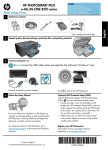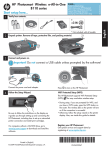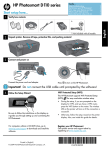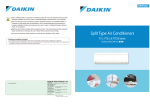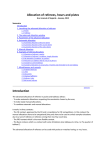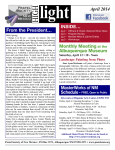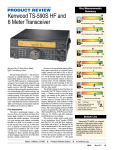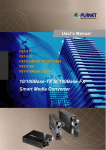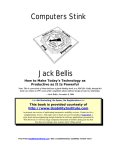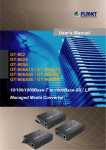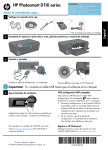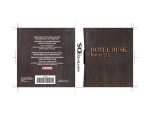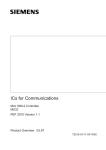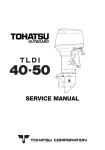Download November 2004 - Fletcher, Heald & Hildreth
Transcript
FHH Telecom Law Current Issues in Telecommunications Law and Regulation Wire the ILECs smiling? Creative outlet FCC Drops Unbundling for Fiber-to-the-Curb FCC OKs IP over AC Mitchell Lazarus 703-812-0440 [email protected] B Paul J. Feldman 703-812-0403 [email protected] roadband over Power Lines (“BPL”) is the newest alternative to DSL and cable for high-speed Internet service at home. Customers seem to enjoy having two-way, high-speed access at every electric outlet in the house. “Just like plugging in an appliance,” they say. Or plug in a Wi-Fi unit instead and take your laptop out on the The deck. On The The FCC has resolved a years-long, hard-fought proceeding in which licensed radio users -- mostly amateur radio operators -- vigorously opposed BPL. They feared the radio-frequency signals used to carry broadband information would leak off the power lines, causing interference to radio communications. The docket filled with dueling filings between the amateurs, who predicted BPL would turn a city’s power distribution system into a giant transmitting antenna, and BPL providers, who claimed their equipment was no more interfering than ordinary household digital devices. The new rules will let BPL go forward. But they also set up extraordinary measures intended to prevent interference and mitigate it if it occurs. Among these: , BPL providers must consult on frequency usage with public safety agencies and certain government and aeronautical stations. , BPL must avoid certain frequencies everywhere, and certain other frequencies near specific sites. , November 2004 Individual BPL devices on the power lines must (Continued on page 4) T he FCC has eased incumbent local exchange carriers’ obligations to unbundle certain elements of their broadband networks. Previously, the FCC had ruled that the incumbents need not offer their competitors access to newly constructed fiber-to-the-home FCC (“FTTH”) loops. The FCC has now High Wire extended that relief to newly constructed fiber-to-the-curb (“FTTC”) loops as well. The FCC defines FTTC as a fiber transmission facility that connects to a copper distribution plant not more than 500 feet from the customer premises. As in the previous decision on FTTH, the FCC relieved incumbent local exchange carriers of the requirement to provide unbundled access to FTTC loops that connect to new customer premises. In cases where new fiber replaces copper loops to an existing customer premise, incumbents must make either a copper loop or a 64 kbps fiber transmission path available to competitors. While a majority of FCC Commissioners agree this policy will promote construction of broadband networks and encourage competition, Commissioner Copps believes the approach is a further blow to the competitive local exchange carrier industry. The decision is likely to stand nonetheless, barring a significant change in the membership of the FCC or an appeal to a court other than the D.C. Circuit, which recently upheld the FCC’s FTTH policy. In a separate action, the FCC extended a previous ruling that forbore from requiring the Regional Bell Oper(Continued on page 3) Page 2 FHH Telecom Law November 2004 A fter years of what Chairman Michael Powell called the most ruthless lobbying he had ever seen, last July it appeared the FCC had finally decided not only how to reshuffle the 800 MHz band, but also who would pay for the changes. The public safety community had long complained that their 800 MHz transmissions were interfered with by commercial SMR operations on the interleaved adjacent channels, mostly owned and operated by Nextel. Nextel proposed to solve the problem -- and also to cure its own lack of 2 GHz PCS spectrum -- by giving up its 800 MHz channels, paying to relocate the public safety community to those channels, and relocating itself to 10 MHz of prime spectrum at 1910-1915 and 1990-1995 MHz, which it asked the FCC to give it in exchange. Although Nextel offered to pay $850 million toward the relocation costs, cellular competitors howled that the 1900 MHz spectrum was worth closer to $6 billion, resulting in a huge windfall to Nextel. The lead opponent of the deal, Verizon Wireless, at one point threatened the FCC Commissioners with personal criminal prosecution if they proceeded with the deal. The tactic backfired, causing a bitterly divided FCC to coalesce behind the Nextel plan, albeit in altered form. The FCC's July decision valued the 1.9 GHz going to Nextel at $4.8 billion. After a credit of $1.6 billion for the frequencies Nextel will vacate, plus credit for the actual cost of relocating the public safety community, the FCC proposed to bill Nextel for the remaining $2.35 billion. Fletcher, Heald & Hildreth A Professional Limited Liability Company 1300 N. 17th Street - 11th Floor Arlington, Virginia 22209 Tel FHH Telecom Law November 2004 Page 3 Can you hear me now? FCC Promotes Rural Wireless Steve Lovelady 703-812-0517 [email protected] T he FCC has released long-awaited rules to help spread wireless services to rural areas, augmented with a Further Notice of Proposed Rulemaking on unresolved issues. Now, the FCC will allow commercial and private terrestrial wireless service licensees to grant security interests in a license, but only to the Department of Agriculture’s Rural Utilities Service -- not to any other lender. In the Commission’s view, this should open up a major source of capital for companies interested in acquiring spectrum and building facilities to bring new wireless services to rural areas. But the FCC still retains the right to approve any change in control resulting from licensees’ defaults. The FCC defined “rural area” as a county with an average population density of 100 persons or less per square mile, based on current census data. This criterion makes 2,331 counties rural areas, with a population of 60 million -- 71% of the U.S. counties The FCC will allow with 21% of the population. But commercial and private the FCC considers the new definiterrestrial wireless service tion to be only a presumption that licensees to grant security can be altered to fit specific circumstances. interests in a license, but only to Also, the FCC ended the remaining components of the cellular crossinterest rule applicable to rural licensees, replacing the general prohibition of certain cross-ownerships the Department of Agriculture’s with case-by-case analyses. It estabThe FCC also responded to carriRural Utilities Service. lished “safe harbor” standards for ers’ complaints about their inabilcarriers subject to construction ity to gain access to spectrum in benchmark requirements. It inrural markets. But rather than creased the power limits for rural area wireless base adopt a specific policy of establishing service areas stations, so that larger areas can be covered with fewer based on county lines or other fixed boundaries, the facilities. And it eased its position on infrastructure FCC prefers to consider each service and technology sharing agreements between and among licensees. separately, and to adopt different service areas based on the particular nature of each, in hopes this will cre- This last shift in policy will encourage licensees to enter into economically effective facility sharing agreeate flexibility and opportunities for rural carriers and ments and thus reduce the overall cost of providing encourage efficient use of spectrum. The FCC also wants more time to explore the use of secondary mar- services to rural areas. kets mechanisms to redistribute “unused” spectrum in areas that were previously licensed, but for which the licensees failed to timely construct facilities. But (Fiber to the Curb - continued from page 1) less than a year has gone by since the secondary marating Companies to unbundle broadband networks ket leasing rules went into effect -- not enough time used to provide FTTH, FTTC, and certain other to determine their effectiveness. functions. Where the earlier ruling applied to Section 251 of the Telecommunications Act of 1996, which To facilitate access to capital, the FCC relaxed a longgoverns local competition, the recent action extends standing barrier to wireless carriers’ securing loans. the same relief under Section 271, which governs the Previously, licensees could mortgage their company Bell Companies’ entry into long-distance markets. stock, accounts receivable, etc., but not their licenses. Page 4 FHH Telecom Law Will three be the charm? Streamlined Tower Review On the Horizon PCS Re-Auction, Déjà Vu Michael Richards 703-812-0456 [email protected] R.J. Quianzon 703-812-0424 [email protected] N ow on its third try, the FCC will once again re-auction certain PCS spectrum across the nation. Most of the spectrum at issue was initially won at auction during the 1990s by NextWave Personal Communication. After NextWave declared bankruptcy, the FCC auctioned the licenses again in 2000-2001. But the U.S. Supreme Court ruled the FCC lacked authority to do that while NextWave operated under the protection of the Bankruptcy Code, and returned the licenses to NextWave. Now the FCC will take another shot. The 242 licenses range from 1850-1990 MHz in relatively small economic areas, typically a city and a few neighboring counties. About half will be available only to “entrepreneurs” -- i.e., entities that, together with their controlling interests, have less than a half-billion dollars in total assets and average annual revenues of less than $125,000,000. The other licenses are available to anyone, but small businesses will receive a discount. Bidders with less than $40 million in annual revenue will get 15% off, and those bidders with less than $15 million, 25% off. Potential bidders must apply by November 30. Upfront payments -- refundable earnest money required to participate -- must be submitted by December 29. Bidding begins on January 26, 2005. (Broadband over Power Lines - continued from page 1) be remote-controllable to exclude frequencies that cause interference at particular locations. , BPL providers must establish a publicly- accessible database of their installations to facilitate resolving interference issues. In addition, the FCC established new technical November 2004 T he wired nation is going wireless. More wireless means more towers, which means more disputes over tower construction. Proposing a tower in or around an historic site can add extra processing delays. And indeed, the FCC reports an “exponential increase” in the number of environmental and historic preservation reviews. These create case backlogs, additional paperwork, and delays in deploying needed infrastructure. The FCC's remedy is to standardize the review process, from application to approval, so that state, federal, Indian tribal, and Hawaiian native organizations charged with protecting heritage sites can all get their reviews done as quickly as possible. New standardized forms are in the works. The same form will work whether submitted to the FCC or to any other historic preservation office. Although pending applications filed on older forms will still be valid, parties that wish to resubmit a tower proposal on the new forms will be able to do so. The new procedures specifically exclude certain tower work from the review process: enhancements to existing towers, replacement and temporary towers, and certain towers constructed on industrial and commercial properties or in utility corridor rights-of-way. The new historic preservation review procedures and forms should be available around the turn of the year. procedures for measuring radio-frequency emissions from BPL devices. Most observers doubt the proceeding is over. At least some licensed radio users are likely to challenge the FCC’s decision. And BPL providers may well dispute some of the new provisions. But we expect they will be deploying in the meantime. Broadband to the people. FCC Telecom Law November 2004 Page 5 Tomorrow and tomorrow and tomorrow creeps . . . 3G Crawls Forward Lee G. Petro 703-812-0453 [email protected] T he FCC continues efforts to pry loose 110 MHz for third generation (3G) wireless services -- more formally known as Advanced Wireless Services (AWS) -- which promise to bring high-speed Internet access, video programming, and other advanced applications to mobile users. Having earlier allocated 1710-1755 and 2110-2155 MHz bands for 3G, the FCC has now found another home for the Government operations that presently use 1710-1755 MHz. Nineteen Department of Defense sites will be moved to the 2025-2110 MHz band and have protection from Broadcast Auxiliary licensees, while aeronautical mobile flight test telemetry operations will be moved to the 2360-2395 MHz band. The FCC had earlier re-designated another 20 MHz for 3G: 1915-1920 MHz, paired with 19952000 MHz; and 2020-2025 MHz, paired with 21752180. These allocations require some way to reimburse unlicensed PCS users at 1915-1920 MHz and Meanwhile, back in the 20th Century . . . Two-G Spectrum Rules Modified In nearby "2G" spectrum, the FCC has modified its rules for the 1920-1930 MHz band to provide additional uses of voice-based systems for unlicensed personal communications services. Specifically, the Commission removed certain channelization requirements, deleted the packing rule, and will permit asynchronous operation in the band. The Commission believes these changes will result in more robust use of the block by wireless PBX systems. Broadcast Auxiliary Service (BAS) licensees at 1995-2000 and 2020-2025 MHz. A proposal is pending whereby Nextel would clear these BAS frequencies, in addition to others that Nextel would acquire in exchange for its 800 MHz spectrum. (See related story on page 2.) If that proposal goes forward and Nextel has in fact cleared 1995-2000 and 2020-2025 MHz before the FCC auctions these frequencies for AWS, then the new licensee will be spared any additional reimbursement payments; otherwise the AWS licensee will be responsible for the BAS relocation. In any event, the AWS licensee will have to relocate the incumbent users from 2175-2180 MHz. The FCC issued a Notice of Proposed Rulemaking on auction rules, technical rules, and allocation of relocation costs for this 20 MHz. Comments are due on November 23, 2004, and reply comments on January 7, 2004. It’s almost 2005—Do you know where your proceedings are? Due dates for filings in FCC proceedings are subject to last-minute change. Call us any time for current information. FHH Telecom Law Page 6 November 2004 FOIA information Will the FCC Keep Your Secrets? Mitchell Lazarus 703-812-0440 [email protected] W e get questions on how the FCC handles confidential information in certification applications. Here are some answers. Legal Basis The Freedom of Information Act (“FOIA”) generally requires federal agencies to disclose their records on request. Agency records include most documents submitted to the agency by members of the public. That makes an FCC certification application, together with all of its exhibits and correspondence, an agency record for FOIA purposes, and hence presumptively subject to disclosure. But FOIA also permits an agency to withhold from the public “trade secrets and commercial or financial information obtained from a person and privileged or confidential.” Under this provision, the FCC can lawfully keep certain parts of a certification application from public disclosure. tion) until a date specified by the applicant. Typically this is the date the product will be announced. An applicant makes the request by ticking off the appropriate box on Form 731 (certification application). There is no additional charge. The FCC can decline to honor requests that made after the application is filed. 2. Delayed Disclosure On proper request, the FCC will delay disclosure of certain application exhibits for 45 days following grant of the certification. These include the external and internal photos, test setup photos, block diagram, schematics, user’s manual, parts list, tune-up procedures, and The FCC always treats operational description. The delay is a certification application as meant to give manufacturers and imconfidential until it is granted. porters time to deliver the product to Unless the applicant requests retailers and prepare for marketing. This option is useful because shipotherwise, on the day of the ment to retailers -- or anywhere else -grant the FCC will post is prohibited prior to the grant of certhe entire application tification, which ordinarily triggers on its website. disclosure. Default Rule The FCC always treats a certification application as confidential until it is granted. Unless the applicant requests otherwise, on the day of the grant the FCC will post the entire application on its website, including all of the exhibits and correspondence. (If the FCC denies an application, the application never becomes public.) An applicant can seek to alter the automatic disclosure in three different ways. These can be used individually or in any combination. 1. Delayed Grant On proper request, the FCC will postpone grant of certification (and hence disclosure of the applica- Like a delayed grant, delayed disclosure must be requested in the original filing of Form 731. There is an additional charge. The delay can be extended for a second 45 days, but the extension request must reach the FCC at least seven calendar days before the first 45 days expires. There is no additional charge for the extension. Delayed disclosure comes with an obligation. The certification grantee must notify the FCC or TCB promptly if it “engages in public marketing activities” or otherwise publicizes the device. The FCC will then post the complete application on its website (except for materials withheld permanently, as below). (Continued on page 7) FHH Telecom Law November 2004 Page 7 “Before we look at your application, let’s have a chat about that money you owe us . . .” FCC Implements New Debt Collection Procedures Applications dismissed if old bills not paid Donald J. Evans 703-812-0430 [email protected] T he FCC has adopted new rules in an effort to crack down on deadbeat licensees and applicants. By comparing the applicant’s FCC Registration Number (“FRN”) with a roster of FRNs showing delinquent debts to the agency, the FCC can put a “red light” on the processing of any application filed by deadbeats. The FCC will cross-check not only FRNs for unpaid debts, but also the underlying Taxpayer Identification Numbers (employer ID or social security numbers), so an applicant cannot avoid the red light just by opening a new FRN. Debts owed to the Universal Service Fund, the TRS Fund, and other FCC-mandated funds will all come under the delinquent debt umbrella, along with annual regulatory fees and application fees. On the positive side, delinquent applicants will receive a notice of their delinquency so that they can cure it (with appropriate penalties) in time to get an application granted. The notice will go only to the person listed as a contact on the CORES account, so it wise to make sure the contact information is current. The FCC also has a resource on its website called “Red Light Check” that enables an entity to determine instantly whether it is subject to a red light for any reason. Access requires the entity’s FRN and passcode. Think the FCC isn’t serious about holding delinquents responsible? One applicant took out a $2,240 govern- ment-backed student loan in 1985 and defaulted, but by 1992 had paid up with interest. Fast forward to now, when an auction participant must pay 50% more up front if it previously defaulted on any “non-tax debt owed to any Federal agency.” The applicant voluntarily ’fessed up to his long-since-corrected delict and, noting the default was cured more than a decade ago, asked for a waiver of the 50% premium. Sorry, said the FCC. The “rules and the integrity of the competitive bidding process are best served by applying the upfront payment requirement in a fair and consistent manner.” The Government never forgets. Your Euros Or Your Life, S’il Vous Plaît The FCC has opened a preliminary inquiry into whether termination charges levied by foreign carriers on U.S. mobile customers traveling abroad are reasonable and fair. Concerned about anecdotal reports of exorbitantly high foreign termination rates, the FCC has begun gathering facts about existing agreements between carriers on such charges, the level of charges, and how foreign regulators handle this issue. Although no specific action is proposed at this time, the FCC is encouraging interested parties to aid it in developing the record. Comments may be filed in Docket No. IB 02-324. (Confidentiality - continued from page 6) 3. Permanent Confidentiality On proper request, the FCC will withhold a smaller category of exhibits from the public on a permanent basis. These include the block diagram, schematics, parts list, tune up procedures, and operational description. The FCC assumes that information contained in other parts of the application (internal and external photos, manual, etc.) is not “confidential” under the FOIA statute, inasmuch as it becomes available to anyone purchasing the product. But the FCC will also withhold other exhibits on a showing that the information they contain cannot easily be obtained or reverse-engineered from the product. This category of confidentiality also must be requested on the original Form 731, and incurs an additional charge. The FCC’s initial determination to withhold a particular exhibit is only provisional. If the FCC receives a request under FOIA for such an exhibit, it notifies the certification grantee, and only then litigates whether the exhibit qualifies to be withheld. If it determines to disclose the exhibit, it will delay doing so for a short time so the grantee has an opportunity to appeal the disclosure in court. Other questions? Give us a call.







